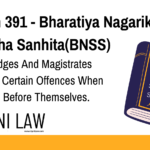Code
Judgment Requirements
(1) Except as otherwise expressly provided by this Sanhita, every judgment
referred to in section 392,—
(a) shall be written in the language of the Court;
(b) shall contain the point or points for determination, the decision thereon and
the reasons for the decision;
(c) shall specify the offence (if any) of which, and the section of the Bharatiya
Nyaya Sanhita, 2023 or other law under which, the accused is convicted, and the
punishment to which he is sentenced;
(d) if it be a judgment of acquittal, shall state the offence of which the accused
is acquitted and direct that he be set at liberty.
(2) When the conviction is under the Bharatiya Nyaya Sanhita, 2023 and it is doubtful
under which of two sections, or under which of two parts of the same section, of that
Sanhita the offence falls, the Court shall distinctly express the same, and pass judgment in
the alternative.
(3) When the conviction is for an offence punishable with death or, in the alternative,
with imprisonment for life or imprisonment for a term of years, the judgment shall state the
reasons for the sentence awarded, and, in the case of sentence of death, the special reasons
for such sentence.
(4) When the conviction is for an offence punishable with imprisonment for a term of
one year or more, but the Court imposes a sentence of imprisonment for a term of less than
three months, it shall record its reasons for awarding such sentence, unless the sentence is
one of imprisonment till the rising of the Court or unless the case was tried summarily under
the provisions of this Sanhita.
(5) When any person is sentenced to death, the sentence shall direct that he be
hanged by the neck till he is dead.
(6) Every order under section 136 or sub-section (2) of section 157 and every final
order made under section 144, section 164 or section 166 shall contain the point or points for
determination, the decision thereon and the reasons for the decision.
Explanation of Section 393 BNSS
Section 393 of the Bharatiya Nyaya Sanhita (BNSS) specifies the format and details required in every judgment delivered in a criminal trial. It ensures that the judgment is comprehensive, clear, and consistent, providing transparency in the judicial process.
Key Provisions:
- Language and Content of Judgment
The judgment must be written in the language of the Court, and must clearly state:- The points for determination.
- The decision on each point.
- The reasons for the decision.
- If the accused is convicted, the specific offence and the applicable section(s) of the Bharatiya Nyaya Sanhita, along with the punishment.
- In case of acquittal, the judgment must state the offence the accused is acquitted of and direct that they be set free.
- Alternative Judgment
If the offence falls under two potential sections or parts of the Sanhita, the Court must clearly express the uncertainty and pass an alternative judgment. - Reasons for Specific Sentences
- If the conviction is for an offence punishable with death, or an alternative of life imprisonment or imprisonment for a term of years, the judgment must include reasons for awarding such a sentence. In the case of death sentence, special reasons must be provided.
- If the sentence is less than three months for a conviction punishable with one year or more imprisonment, the Court must record reasons for such a reduced sentence unless it is a summary trial or a sentence of imprisonment till the rising of the Court.
- Death Sentence
If the accused is sentenced to death, the judgment must specifically direct that they be hanged by the neck till they are dead. - Orders and Final Orders
Every order under sections 136, 157, 144, 164, or 166 must contain:- The points for determination.
- The decision.
- The reasons for the decision.
Illustrations
Example 1: Detailed Judgment with Acquittal
The judge convicts the accused under section 302 for murder and imposes life imprisonment. The judgment is written in the Court’s language, specifies the offence, the applicable section of the Sanhita, and the punishment. In case of acquittal, the judgment states the offence the accused was acquitted of and directs that they be released.
Example 2: Death Sentence
If the accused is convicted for a capital offence, the judgment includes special reasons for imposing the death sentence, such as the severity of the crime or aggravating circumstances.
Example 3: Reduced Imprisonment
The Court may convict the accused for theft punishable with one year imprisonment but imposes a sentence of three months. The judgment includes reasons for the reduced sentence, such as the accused’s remorse or first-time offense.
Common Questions and Answers on Section 393 BNSS
1. What happens if the conviction is for a capital offence?
The judgment must specify the reasons for awarding the death sentence, and in the case of death, it must explicitly direct the hanging.
2. Is the Court required to justify a reduced sentence?
Yes, if the Court imposes a sentence of imprisonment for less than three months, it must provide reasons, unless the case is tried summarily or the sentence is till the rising of the Court.
3. What is required in the case of an acquittal?
In case of acquittal, the judgment must state the offence the accused was acquitted of and direct their release.
Conclusion
Section 393 of the Bharatiya Nyaya Sanhita (BNSS) sets the standard for the structure and comprehensiveness of judgments in criminal cases, ensuring that the reasoning behind convictions, sentences, and acquittals is made clear and transparent. This section promotes accountability and clarity in the judicial process, safeguarding the rights of the accused and ensuring the public understands the rationale behind the decisions of the Court.










